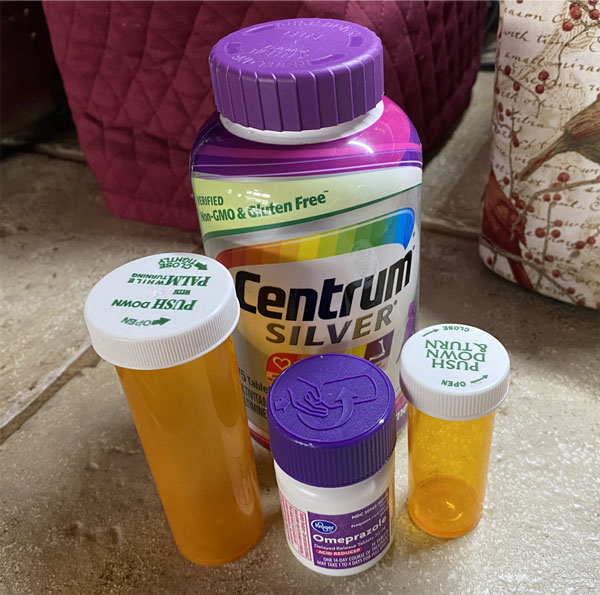This summer, many families are planning and attending events that have been postponed due to the COVID-19 pandemic. People are traveling to family reunions, graduations, weddings and celebrations of life. Visiting grandma and grandpa is no longer limited to video calls or socially distanced interactions. That’s a wonderful thing!
A couple of months ago, I hosted a long-delayed birthday party in honor of our father’s 93rd birthday. We were lucky enough to have all of us fully vaccinated, and all of my siblings (2 brothers and 3 sisters) were able to come. It was a PARTY!
Whew! It was great to see each other again after the year-long gap in being able to visit family and friends. During the months and months of being socially distanced, it can be easy to just leave your prescription medicines out on a counter or table, where they are accessible to small children.
Now that young children can visit their older relatives, there is a risk of an accidental poisoning from ingesting prescription medicines.
Last month, 85-year-old Betty brought in her medicines yesterday for me to review. I noticed how faded the green lettering was on worn white plastic caps of her prescription vials. Many of those child-resistant lids were either sitting crooked or barely fastened, to make them easier to open. One label was nearly 5 years old with newly refilled pills inside.
The challenge of opening child-resistant tops is not limited to medicine bottles. Vitamins, non-prescription medicines, and many everyday liquid household products are sold with hard-to-open lids, including paint thinners, cleaning solutions, and bleach.
The widespread use of child-resistant lids addresses a severe problem: accidental child poisonings.
In the 1960s, the most common documented cause of injury in children under 5 years old was accidentally swallowing medicines or household cleaners. In 1970 the United States Congress passed the Poison Prevention Packaging Act (PPPA). This law required all prescription and non-prescription drugs that could be swallowed to have child-resistant (C-R) packaging.
In the decades since that law was enacted, C-R packaging has saved many young lives. Unfortunately, it also causes significant inconvenience for many adults, especially those with below-average strength and dexterity. Ironically, those are also the people who take the most medicine.
Since 1974, pharmacists have been required to dispense all medication refills in brand new vials and lids. As medicine bottles get used, they “break-in,” making the caps easier to open. Eventually, those tops are no able to meet the C-R standard. Pharmacists must dispense ALL medicines with C-R lids except for under-the-tongue tablets of nitroglycerin. The only exception is if the patient requests otherwise in writing and signs it.
A lid is considered child-resistant if a child under 5 cannot open it within 5 minutes, but 90% of adults can open and close it within 5 minutes. Who wants to fight with a lid to get it to open and close? No wonder Delores re-used her prescription bottles that had worn-out lids!
30 years ago, I ripped apart a ligament in my right wrist. Not only did it really hurt, it put me in a hard cast for 6 LONG weeks and a rigid brace for another 6 weeks. This was a significant handicap, and not just because I am right-handed. I discovered that I could NOT open ANY child-resistant lids while wearing that cast! As a pharmacist, I needed to open a LOT of child-resistant tops at work.
I hated having to interrupt my co-workers to have them open lids for me. Eventually, I worked out a way to open those tricky caps without moving my wrist. Decades later, I’m STILL using that same technique, because it helps me open child-resistant tops easily, without straining my hands or my wrists.
Here’s how I open child-resistant lids without twisting my wrist:
- Pick up the bottle in your right hand and place the palm of your left hand FLAT against the cap so that your hands form a sideways “T.”
Your left hand is turned with your thumb pointing up, and your right hand is perpendicular to it. Imagine your left hand as a door and your right hand reaching out to the doorknob.
- PUSH both hands together using your arms, keeping your wrists straight.
- TURN your entire right forearm slowly clockwise.
It’s like turning a doorknob, but with your WHOLE FOREARM instead of just your wrist. The pressure of your hands pushing toward each other keeps the lid free as your right arm turns. You don’t have to turn your arm very far before the cap disengages.
- Turn the container, so the cap is facing up.
When you feel the cap come free, tip the container so the cap faces back up to prevent the contents from spilling out.
- Lift the lid free.
Cup the lid with your left palm and separate your hands, one holding the cap and one holding the container. It’s open!
- Reverse the steps to seal the container.
To put the top back on, reverse the order of the steps: form a T, push your hands together, and turn your right forearm to the left (counterclockwise) until it engages.
If you have trouble opening child-resistant bottles, PLEASE don’t leave the lids half on, for them to spill open. You can request “easy-open” lids for medicines at your pharmacy by requesting and signing a release form. And make sure you store ALL medicines away from easy access by young children.


